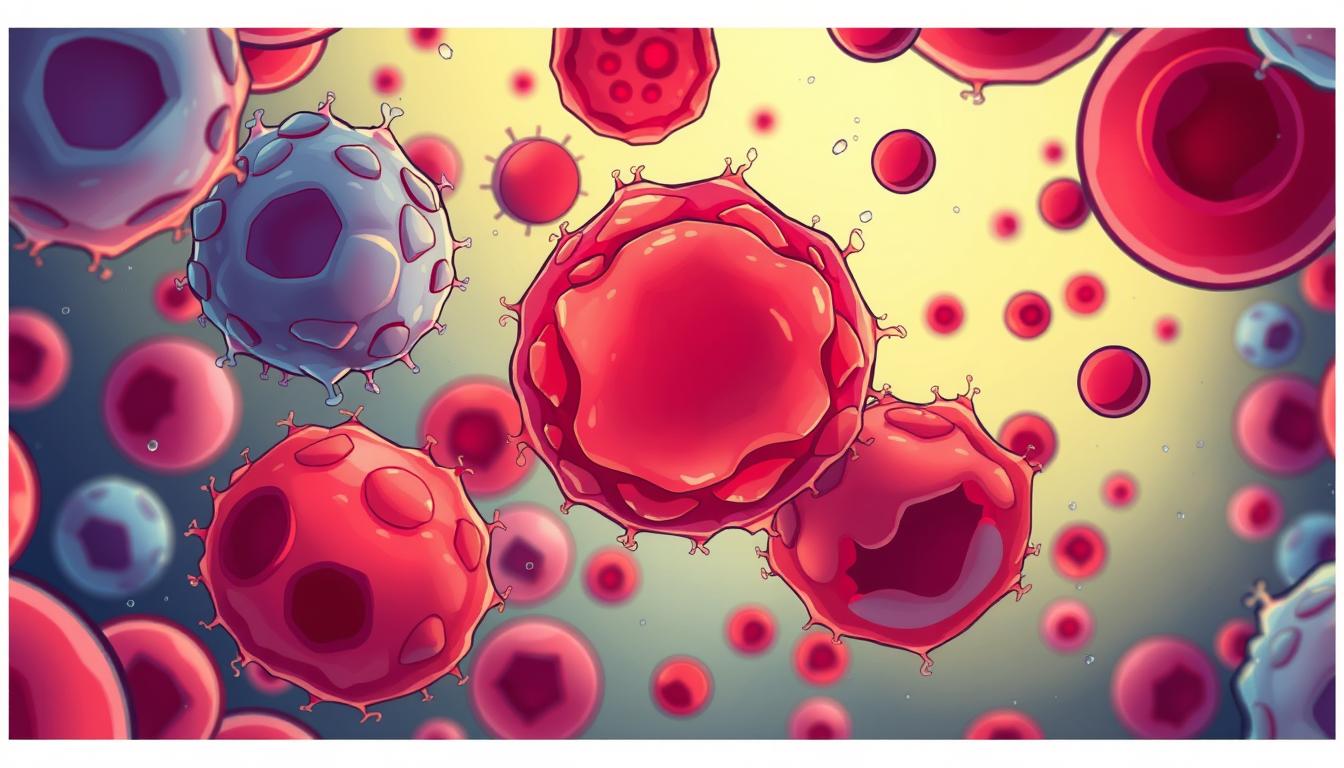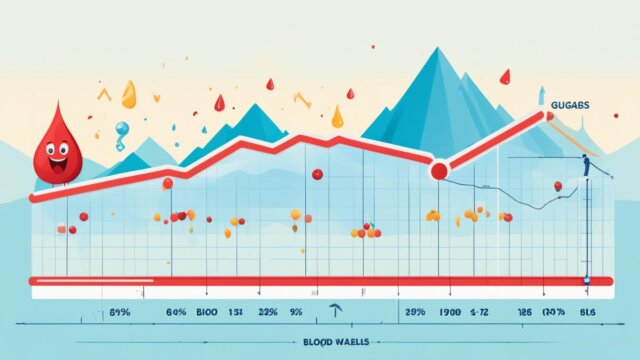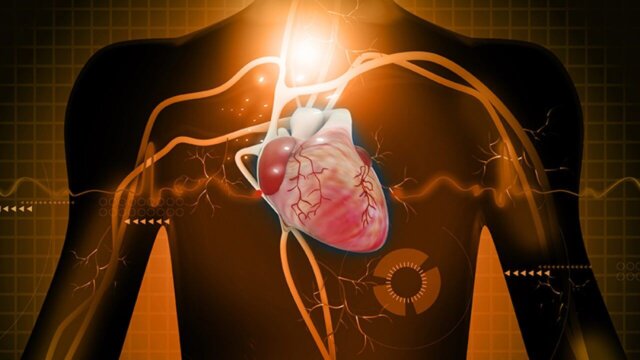FTC disclaimer: This post may contains affiliate links and we will be compensated if you click on a link and make a purchase.
Acute lymphocytic leukemia (ALL) is a serious diagnosis. It’s a fast-growing blood cancer that can be deadly in just a few months. But, with today’s treatments, many people, especially kids, can get better and live long lives. Knowing about this disease is the first step to facing its challenges.
Key Takeaways
- Acute lymphocytic leukemia (ALL) is the most common type of cancer in children.
- ALL mainly affects early lymphocytes, a key white blood cell for our immune system.
- Treatments like chemotherapy and stem cell transplants can cure many, especially kids.
- Things like past cancer treatment, radiation, and genetic disorders can raise your risk of ALL.
- Quick diagnosis and treatment are key, as ALL can quickly get worse if not treated.
What is Acute Lymphocytic Leukemia?
Acute Lymphocytic Leukemia Overview
Acute lymphocytic leukemia (ALL) is a cancer that affects the blood and bone marrow. It happens when the body makes too many immature white blood cells called lymphoblasts. These cells take over, causing symptoms.
ALL is the most common childhood cancer, but it also affects adults. It grows fast and needs quick treatment.
In the last 30 years, more adults with ALL have been treated and lived longer. DNA changes that cause ALL usually happen during a person’s life, not from their parents. Being exposed to certain treatments and having certain genetic conditions can increase the risk of getting ALL.
Children and teens under 15 are most likely to get ALL. Boys are more likely to get it than girls. In the U.S., Hispanics and whites are more likely to get ALL than others.
More cases of ALL are happening because of treatments, as studies by Tan et al. (2017) and Rosenberg et al. (2017) show. A specific type of ALL linked to certain treatments is becoming more common, as seen in Andersen et al. (2001).

Genetics plays a part in childhood ALL, with research by Hernandez-Gonzalez et al. (2017) looking at certain genes. Studies by Igwe et al. (2017) show that some adults with ALL can still be treated well, even with certain genetic changes.
“Most children with Acute Lymphoblastic Leukemia (ALL) are cured of their disease after treatment.”
Symptoms of Acute Lymphocytic Leukemia
Acute lymphocytic leukemia (ALL) can show symptoms that seem like the flu. Symptoms of ALL can affect both men and women the same way. Feeling tired, weak, dizzy, and short of breath are common signs.
Having pale skin and infections that won’t go away are also symptoms. Women might experience heavy menstrual bleeding. ALL can also cause bruising and bleeding gums.
Weight loss, fever, and night sweats are signs of ALL. Loss of appetite is another symptom. Swelling in the abdomen and lumps under the skin are also common.
Bone or joint pain can happen when leukemia cells gather near bones or joints. ALL spreading to other organs can cause headaches and trouble breathing. Fluid buildup in the chest is another symptom.
The T-cell subtype of ALL can affect the thymus. This can cause coughing and trouble breathing. An enlarged thymus can also cause swelling in the face and neck.
If you keep feeling sick, see a doctor. They can diagnose and treat ALL early. This can improve your chances of getting better.
Causes and Risk Factors
The exact cause of acute lymphocytic leukemia (ALL) is still a mystery. It’s thought to be linked to genetic mutations in blood cells in the bone marrow. These mutations cause immature lymphocytes to grow and divide uncontrollably, leading to ALL.
Genetic Mutations and Acute Lymphocytic Leukemia
Most ALL cases don’t have clear risk factors. But some genetic and environmental factors can increase the risk. Known risk factors include:
- High radiation exposure, like from atomic bombs, can raise the risk of ALL and AML.
- Chemicals like benzene in products and cigarette smoke may increase ALL risk, more so for AML.
- HTLV-1 virus infection can cause rare T-cell ALL, common in Japan and the Caribbean.
- Genetic syndromes like Down syndrome can also raise the risk of ALL.
ALL is more common in kids and adults over 50, and in White people compared to African Americans. It’s also more common in males. If an identical twin gets ALL in the first year, the other twin’s risk goes up too.
Studies on electromagnetic fields, workplace chemicals, smoking, and hair dyes haven’t found a clear link to ALL.
Risk Factor | Increased Risk of Acute Lymphocytic Leukemia |
|---|---|
Exposure to high levels of radiation | Yes |
Certain chemical exposures (e.g., benzene) | Yes |
Infection with HTLV-1 virus | Yes |
Genetic syndromes (e.g., Down syndrome) | Yes |
Age (children and adults over 50) | Yes |
Race (White individuals) | Yes |
Gender (male) | Yes |
Identical twin with ALL in first year of life | Yes |
Exposure to electromagnetic fields, workplace chemicals, smoking, hair dyes | Inconclusive |
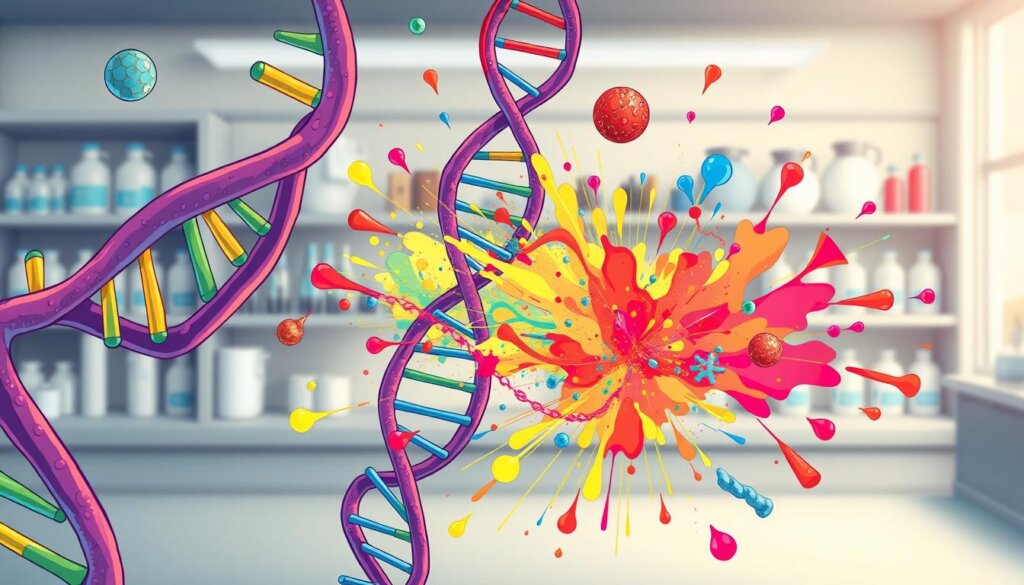
Diagnosis of Acute Lymphocytic Leukemia
Diagnosing acute lymphocytic leukemia (ALL) involves many steps. These include a physical check-up, looking at your medical history, and blood and bone marrow tests. People with ALL often have too many immature white blood cells in their blood.
To confirm ALL, doctors take a bone marrow sample. This is done through a bone marrow aspiration and biopsy.
Genetic and molecular tests are key in diagnosing and treating ALL. About 25% of adults with ALL have a specific genetic change. This can be found through special tests.
Tests like FISH and PCR give quick and accurate results. They help find specific genetic changes in ALL.
A lumbar puncture (spinal tap) might also be done. It checks if the cancer has spread to the brain or spinal cord. This test helps doctors plan the best treatment.
Diagnostic Test | Purpose |
|---|---|
Complete Blood Count (CBC) | Detects abnormal levels of blood cells, including lymphoblasts |
Bone Marrow Aspiration and Biopsy | Confirms the presence of at least 20% lymphoblasts in the bone marrow |
Cytogenetic Analysis | Identifies chromosome and genetic changes in leukemia cells |
Immunophenotyping | Determines the subtype of ALL (B-cell or T-cell) |
Molecular Genetic Testing | Detects specific gene mutations and chromosomal abnormalities |
Lumbar Puncture | Checks for the spread of ALL to the central nervous system |
The detailed diagnostic process for ALL helps doctors create a treatment plan. This plan is made just for the patient’s needs and disease.
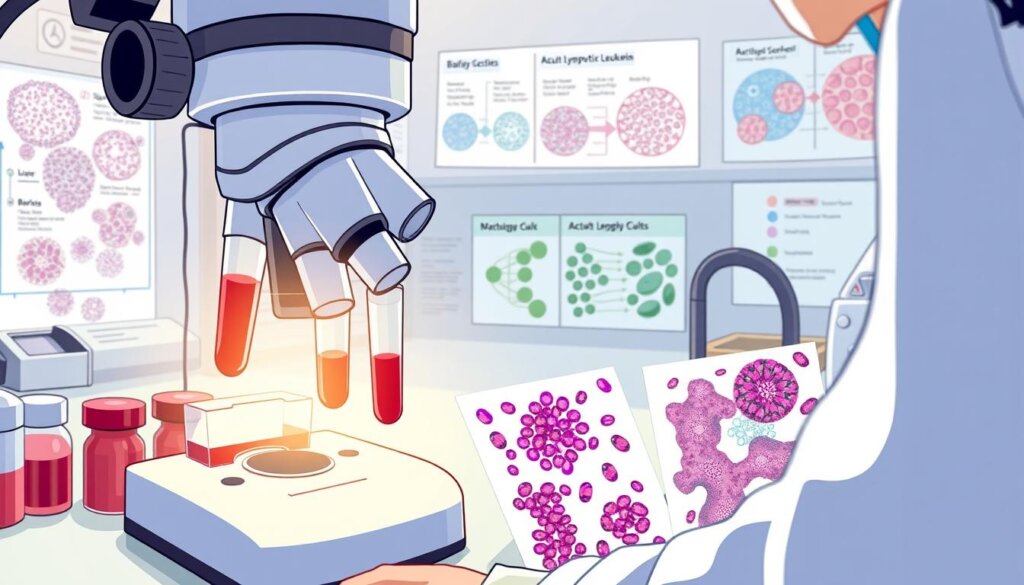
Treatment Options for Acute Lymphocytic Leukemia
Chemotherapy, Radiation, and Stem Cell Transplant
Acute lymphocytic leukemia (ALL) treatment has two main parts. The first part, called induction therapy, tries to get rid of cancer cells in the blood and bone marrow. Chemotherapy is the main tool for this.
The second part, post-remission therapy, aims to keep cancer from coming back. It might include more chemotherapy, radiation, or a stem cell transplant.
Targeted therapies that focus on cancer cell abnormalities are also used. Sometimes, treatments are given directly to the spinal cord to stop cancer from spreading there.
For those with high-risk ALL, a bone marrow or stem cell transplant is often the best choice. This uses healthy cells from a donor to replace bad ones. If a donor isn’t found, the patient might get their own cells back after treatment.
Clinical trials offer new treatment chances for ALL, but they come with unknown risks and benefits. Talking to your doctor about joining a trial can help you decide.
Treatment for ALL usually lasts two to three years, aiming for and keeping remission. Older adults face more challenges and have a worse outlook than younger patients.
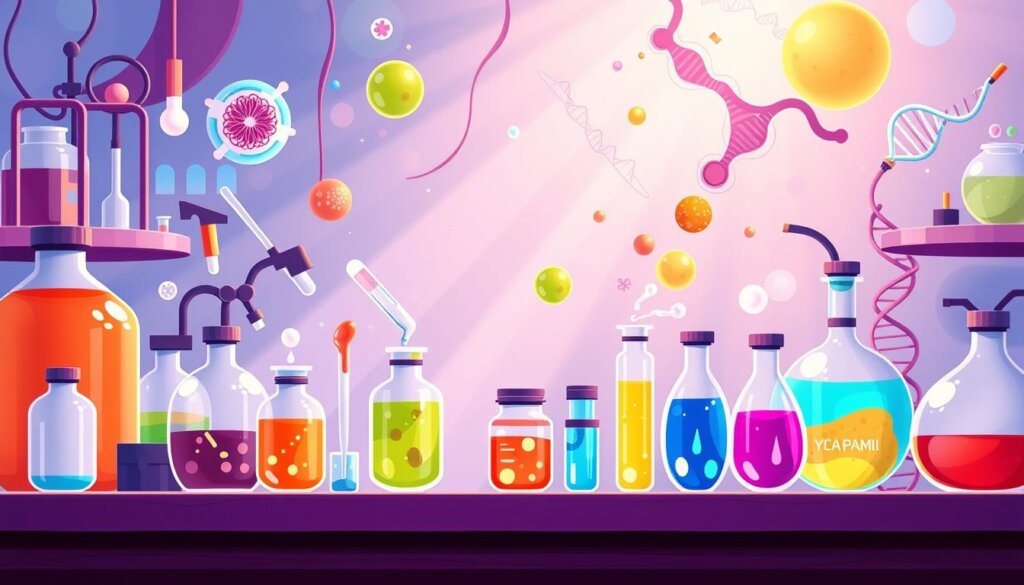
Prognosis and Survival Rates
The outlook for acute lymphocytic leukemia (ALL) varies a lot. The 5-year survival rate for ALL is 71.3%. But kids and young adults do better than older people.
People under 50 usually have a better chance of beating ALL. Things like white blood cell count and how well treatment works also matter. Staying in remission is key, as relapse makes treatment harder.
Places like Roswell Park Comprehensive Cancer Center offer special care and new treatments. Research and trials are looking into new ways to fight ALL, like targeted and immunotherapies.
Thanks to better treatments and care, many people with ALL are living longer. Knowing what affects your chances can help you and your doctors make better plans.
Prevention and Screening
There’s no known way to prevent acute lymphocytic leukemia (ALL). But, managing risk factors can help. High radiation, past cancer treatments, and genetic issues like Down syndrome are important. Taking folic acid during pregnancy might lower childhood ALL risk.
Checking for anemia in moms and iron supplements could also help.
Seeing a doctor often and acting fast on symptoms is key for early ALL detection. This can lead to better treatment results. Doctors use blood tests, scans, and biopsies to find leukemia.
The Malignant Hematology Program at Moffitt Cancer Center helps those at risk. They offer prevention, detection, and treatment services. No referral is needed to talk to their team.
“Early exposure to environmental pathogens could be beneficial in reducing the risk of childhood ALL and other diseases.”
Living with Acute Lymphocytic Leukemia
Coping and Support
Living with acute lymphocytic leukemia (ALL) is tough, both in body and mind. But, with the right help and ways to cope, people can live well during and after treatment.
Knowing the long-term treatment plan is key. ALL treatment lasts at least 2 years. Follow-up care includes regular exams and tests, often every month at first. Working with your healthcare team to plan your care is important.
Staying healthy is also crucial. Regular exercise, a good diet, and avoiding bad habits like smoking help a lot. While no supplements can stop ALL from coming back, healthy habits support the body.
Emotional and mental support is also vital. Getting help from friends, family, support groups, or mental health experts is very helpful. Being in a support group can give you a sense of community and help you share and learn.
With the right attitude, support, and care, people with ALL can face their challenges. The journey may be hard, but with support and lifestyle changes, patients can aim for long-term remission and a better life.
Research and Clinical Trials
Researchers are always working to better understand and treat acute lymphocytic leukemia (ALL). Clinical trials are key in this effort. They test new treatments like targeted therapies and immunotherapies that could help patients more. By joining clinical trials, patients can try new treatments and help advance ALL research.
The Adult Leukemia Program at top hospitals offers many clinical trial options for ALL patients. These trials come from places like Dana-Farber Brigham Cancer Center and private companies.
Doctors are looking into new treatments for acute leukemia and myelodysplasia. They’re studying treatments like venetoclax with chemotherapy, gene or mutation inhibitors, and T-cell therapies.
Joining clinical trials can give patients new treatment options and help research. It’s important to talk to your doctor about the benefits and risks before joining.
Clinical Trial Opportunities | Focus | Principal Investigators |
|---|---|---|
Acute Myeloid Leukemia (AML) | Newly diagnosed and relapsed/refractory cases, with investigational treatments like venetoclax in combination with intensive chemotherapy and inhibitors targeting specific genes or mutations. | Richard Stone, MD, Daniel DeAngelo, MD, PhD |
Acute Lymphoblastic Leukemia (ALL) | Newly diagnosed and relapsed/refractory cases, with studies combining chemotherapy with agents like venetoclax or inotuzumab ozogamicin, as well as exploring engineered T-cell therapies. | Marlise Luskin, MD, MSCE, Caron Jacobson, MD, MMSc |
By joining clinical trials, ALL patients can help research and get new treatments. The work of doctors and these trials offer hope for fighting blood cancer.
Acute Lymphocytic Leukemia Resources
If you or a loved one has been diagnosed with acute lymphocytic leukemia (ALL), there are many resources to help. These resources offer support, information, and guidance. They help you face the challenges of this disease and find the support you need.
The Leukemia & Lymphoma Society is a top patient advocacy group. They have lots of information and resources for ALL patients. Check out their website to learn about ALL, find support, and get involved.
The American Cancer Society also has a lot to offer. Their website has details on ALL, treatments, and coping strategies. It also connects you with support services and clinical trials. Visit their site for this valuable info.
The National Cancer Institute is another trusted source. They have the latest information on ALL. Their website covers everything from understanding the disease to the newest research and treatments.
Your healthcare team is also a great resource. They can give you information, recommend support services, and connect you with local groups. These resources help you and your loved ones deal with the emotional and practical sides of ALL.
Remember, you’re not alone in this fight. Reach out to these organizations and your healthcare providers. They can help you manage your ALL diagnosis and improve your well-being.
“The support and resources available for those affected by acute lymphocytic leukemia are truly invaluable. They provide the information, guidance, and community needed to navigate this challenging experience.”
Managing acute lymphocytic leukemia means staying informed and connected. Use the resources and support from organizations, healthcare providers, and other patients. This way, you can empower yourself and your loved ones on your journey.
Conclusion
Acute lymphocytic leukemia (ALL) is a serious blood cancer. It mainly hits kids but can also affect adults. While we don’t know the exact, some genetic changes and risk factors are linked to it.
Early detection and treatment are key for a good chance of recovery. This is vital for better long-term results.
Even though kids with ALL often do well, it’s still a big challenge for adults. Researchers are looking for new treatments to help everyone with this tough disease.
In short, acute lymphocytic leukemia is a serious issue. It needs quick diagnosis and thorough treatment for the best results. Knowing about the causes, signs, diagnosis, and treatments helps you support yourself or a loved one through this tough time.
FAQ
What is acute lymphocytic leukemia (ALL)?
Acute lymphocytic leukemia (ALL) is a blood and bone marrow cancer. It happens when the bone marrow makes too many immature white blood cells called lymphoblasts. These cells can’t work right and take up space from healthy cells.
What are the symptoms of acute lymphocytic leukemia?
Symptoms include bleeding gums, bone pain, and fever. You might also get frequent infections, nosebleeds, and swollen lymph nodes. Pale skin, shortness of breath, and feeling very tired are also signs.
What causes acute lymphocytic leukemia?
We don’t know the exact cause of ALL. But it might be linked to genetic changes in bone marrow cells. Risk factors include past cancer treatment, high radiation exposure, and genetic disorders like Down syndrome.
How is acute lymphocytic leukemia diagnosed?
Doctors use a physical exam, medical history, and blood tests to diagnose ALL. Bone marrow tests help find leukemic cells. Genetic tests help figure out the type of ALL and plan treatment.
What are the treatment options for acute lymphocytic leukemia?
Treatment has two parts. The first part, induction therapy, aims to kill cancer cells in blood and bone marrow. This is usually done with chemotherapy. The second part, post-remission therapy, kills any leftover cancer cells. This might include more chemotherapy, radiation, or a stem cell transplant.
What is the prognosis for acute lymphocytic leukemia?
The outlook for ALL depends on age, ALL subtypes, and treatment response. Kids with ALL have a 5-year survival rate of about 90%. Adults face a 5-year survival rate of 30-50%.
Can acute lymphocytic leukemia be prevented?
We don’t know how to prevent ALL because we don’t fully understand its cause. However, managing risk factors like radiation exposure might help lower the risk.
What resources are available for individuals and families affected by acute lymphocytic leukemia?
Many resources exist, like the Leukemia & Lymphoma Society. They offer support and information. The American Cancer Society and National Cancer Institute also have online resources on ALL symptoms, diagnosis, treatment, and research.
